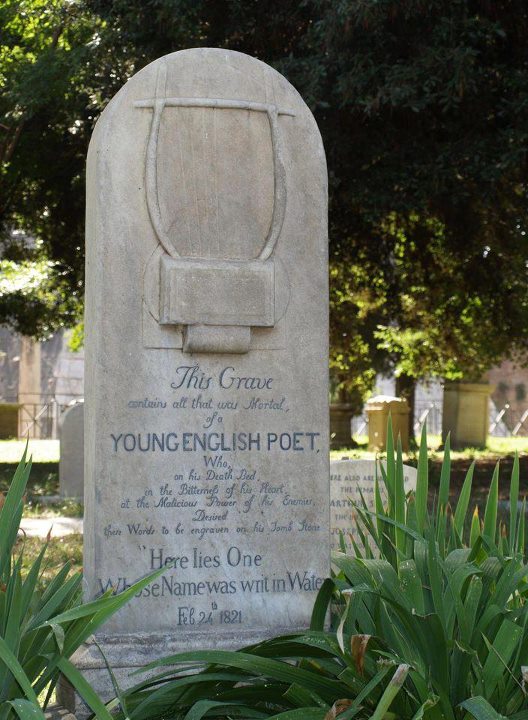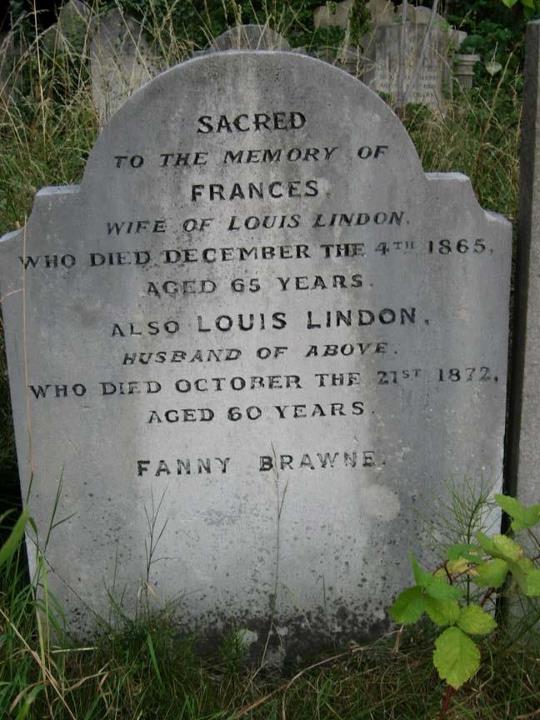John Keats
(31 October 1795 – 23 February 1821)
John Keats is buried in the Protestant Cemetery, Rome, Italy. His grave is in a quiet corner close to the Pyramid. (Shelley is also buried in this cemetery.)
Keats died on the 23 February, 1821 aged only 25. He requested that only the phrase: “Here lies One Whose Name was writ in Water” be inscribed on his headstone. However, his two close friends Joseph Severn and Charles Brown, who cared for him during his illness, decided to add the following:
“This Grave contains all that was mortal, of a YOUNG ENGLISH POET, who on his Death Bed, in the Bitterness of his heart, at the Malicious Power of his enemies, desired these words to be Engraven on his Tomb Stone.”
Fade far away, dissolve, and quite forget
What thou among the leaves hast never known,
The weariness, the fever, and the fret
Here, where men sit and hear each other groan;
Where palsy shakes a few, sad, last grey hairs,
Where youth grows pale, and spectre-thin, and dies;
Where but to think is to be full of sorrow
And leaden-eyed despairs;
Where Beauty cannot keep her lustrous eyes,
Or new Love pine at them beyond to-morrow.
(From Ode to a Nightingale)
Frances (Fanny) Brawne Lindon
(9 August 1800 – 4 December 1865)
Fanny Brawne was engaged to the nineteenth-century English Romantic poet John Keats (from december 1818 until his death in February 1821). The years that spanned the most poetically productive years of Keats’ life. It was through the Dilkes family that the fashionable and steadfast Fanny Brawne met John Keats in November 1818 at Wentworth Place, where Keats had been living for some time with his old friend and roommate Charles Brown in the companion house to the Dilkes’. Keats and Fannys initial meeting was cordial and expected. The Dilkes were fond of Keats and spoke of him to the Brawnes often. Though Fanny’s flirtatious personality contrasts with Keats’ notably more aloof nature, she begins to pursue him. After Keats begins to give poetry lessons to Fanny it becomes apparent that their attraction is highly mutual, however Fanny is nevertheless troubled in regards to Keats’ reluctance to pursue her, for which her mother summarizes, “Mr Keats knows he cannot like you, he has no living and no income”.
When Fanny receives a valentine from Brown, Keats passionately confronts them and wonders if they are lovers. Brown, who sent the valentine in jest, warns Keats of Fanny, claiming that she is a mere flirt playing a game. On the other hand, Fanny, hurt by the accusations and Keats lack of faith in her, ends their lessons and leaves. It is not until after the Dilkes move to Westminster that spring that Fanny and Keats resume their interaction and fall deeply in love.
The relationship comes to an abrupt end, however, after Brown leaves for his summer rental with Keats, so that Keats may earn some money. Though Fanny is heartbroken, she is comforted by Keats’ love letters. When the men return in the autumn, Fanny’s mother shows concern, feeling that Fanny’s attachment with the poet will hinder her from being courted. Secretly, however, Fanny and Keats are engaged.
When Keats becomes ill the following winter, he spends several weeks recovering until spring, for which his friends begin a collection of funds so that he may spend the next winter in Italy where the climate is warmer. Fanny’s mother gives Keats her blessing to marry Fanny once he returns from Italy. The night before Keats must leave for Italy he and Fanny say their tearful goodbye in privacy, and in February, while still in Italy, John Keats dies of complications from tuberculosis.
Fanny cuts her hair in an act of mourning and walks the snowy paths outside that Keats had walked many times in life. It is there that she recites the love sonnet he had written for her, “Bright Star”, as she grieves the death of her lover. She wore the ring Keats had given her for the rest of her life.
It is unclear when Keats first drafted “Bright Star”. His biographers suggest different dates. It has been suggested it was begun in April 1818, before Keats met Fanny, and then revised it for her later. Some believe it to have been in the last week of February 1819, immediately after their informal engagement.
The poem came to be forever associated with Fanny Brawne with whom Keats became infatuated. It was officially published in 1838 in The Plymouth and Devonport Weekly Journal, 17 years after Keats’ death.
Fanny came out of mourning in 1827, six years after Keats’ death. on 15 June 1833, more than twelve years after his death, she married Louis Lindon, and on 4 December 1865, Fanny Brawne died and was buried the next day in Brompton Cemetery.
BRIGHT STAR
Bright star, would I were stedfast as thou art
Not in lone splendour hung aloft the night
And watching, with eternal lids apart,
Like nature’s patient, sleepless Eremite,
The moving waters at their priestlike task
Of pure ablution round earth’s human shores,
Or gazing on the new soft-fallen mask
Of snow upon the mountains and the moors
No – yet still stedfast, still unchangeable,
Pillow’d upon my fair love’s ripening breast,
To feel for ever its soft fall and swell,
Awake for ever in a sweet unrest,
Still, still to hear her tender-taken breath,
And so live ever – or else swoon to death.
External links:
John Keats (Wikipedia)
Ode to a Nightingale (Wikipedia)
Fanny Brawne (Wikipedia)





